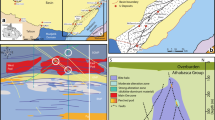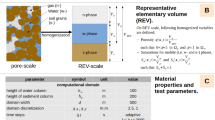Abstract
Both water level drops and erosion have previously been suggested as causes of fluid overpressures in the subsurface. Quantification of the relevance of these processes to supra-lithostatic fluid pressure formation with a wide selection of input parameters is lacking, and thus desired. The magnitudes and drop times that are required for water level drops to result in supra-lithostatic pore pressures in a variety of situations are calculated. Situations with pore fluids consisting of water, water with dissolved methane, water with a gas hydrate layer and dissolved methane in the underlying sediments, and water with dissolved methane, a gas hydrate layer, and free gas accumulation below the hydrate layer are separately addressed. The overpressure formation from reservoir gas expansion is also simulated. The simulation results demonstrate that high fluid overpressures can develop in a rock as a response to a water level drop without the presence of gas, provided that the rock has a sufficiently low compressibility. The contribution to fluid overpressuring is however dramatically increased if the pore water is saturated with methane prior to the water level drop, and is further amplified by the presence of gas hydrates and free gas accumulations beneath such hydrates. Gas expansion in reservoirs should be expected to significantly increase the fluid overpressures in shallow, sealed pressure compartments that experience erosion or water level drops, even if the water level drop duration exceeds one million years. Enough relationships between the calculated overpressure formation and the main controlling factors are provided in order to enable readers to make inferences about a variety of geological settings. Analyses of simulation results prompt us to suggest that pockmarks are likely to be triggered by gas expansion in vertical fluid migration pathways, that the giant craters at the seabed west of Albatross South in the Barents Sea result from hydrate dissociation, and that overpressure build-up due to gas expansion has contributed to reservoir overpressuring in many eroded basins, including the Hammerfest Basin in the Barents Sea.













Similar content being viewed by others
References
Bertoni C, Cartwright J, Hermanrud C (2013) Evidence for large scale methane venting due to rapid sea level drawdown during the Messinian Salinity Crisis. Geology (in press). Article ID 33987
Bredehoeft JD, Hanshaw BB (1968) On the maintenance of anomalous fluid pressures I. Thick sedimentary sequences. Geol Soc Am Bull 79:1097–1106
Carslaw HS, Jaeger JC (1959) Conduction of heat in solids, 2nd edn. Oxford University Press, London. 510 pp
Cartwright JA, Wattrus NJ, Rausch D, Bolton A (2004) Recognition of an early Holocene polygonal fault system in Lake Superior: implications for the compaction of fine-grained sediments. Geology 32:253–256
Cartwright JA, Huuse M, Aplin A (2007) Seal bypass systems. Am Assoc Pet Geol Bull 91(8):1141–1166
Chan GH-N, Malpas J, Xenophontos C, Lo C-H (2008) Magmatism associated with Gondwanaland rifting and Neo-Tethyan oceanic basin development: evidence from the Mamonia Complex, SW Cyprus. J Geol Soc London 165(3):699–709
Chand S, Thorsnes T, Rise L, Brunstad H, Stoddart D, Bøe R, Svolsbru T (2012) Multiple episodes of fluid flow in the SW Barents Sea (Loppa High) evidenced by gas flares, pockmarks and gas hydrate accumulation. Earth Planet Sci Lett 331–332:305–314
Corcoran DV, Doré AG (2002) Top seal assessment in exhumed basins—some insight from Atlantic Margin and borderland basins. In: Koestler AG, Hunsdale R (eds) Hydrocarbon seal quantification. Norw Pet Soc Spec Publ, vol 11. Elsevier, Amsterdam, pp 89–107
Cornée JJ, Moissette P, Joannin S, Suc JP, Quillévéré F, Krijgsman W, Hilgen F, Koskeridou E, Münch P, Lécuyer C, Desvinges P (2006) Tectonic and climatic controls on coastal sedimentation: the late Pliocene–Middle Pleistocene of northeastern Rhodes, Greece. Sediment Geol 187:159–181
Dugan B, Flemings PB (2000) Overpressure and fluid flow in the New Jersey continental slope: implications for slope failure and cold seeps. Science 289(5477):288–291
Evans D (2003) The Millenium Atlas: petroleum geology of the central and northern North Sea. Geol Soc, London. 385 pp
Gidaspow D (1994) Multiphase flow and fluidization. Academic Press, Harcourt Brace & Co, San Diego. 457 pp
Halkjelsvik ME (2012) Exploration models for dry and underfilled traps in the western part of the Hammerfest Basin. MS thesis, University of Bergen, Norway
Hanken N-M (2012) Pers com
Hanken N-M, Bromley R, Miller J (1996) Plio-Pleistocene sedimentation in coastal grabens, north-east Rhodes, Greece. Geol J 31:271–298
Hasan JU, Fredlund DG (1980) Pore pressure parameters for unsaturated rocks. Can Geotech J 17:395–404
Hilbrecht H (1989) Redeposition of Late Cretaceous pelagic sediments controlled by sea-level fluctuations. Geology 17:1072–1075
Huuse M, Cartwright JA, Hurst A, Steinsland N (2007) Seismic characterization of large-scale sandstone intrusions. In: Hurst A, Cartwright JA (eds) Sand injectites: implications for hydrocarbon exploration and production. Am Assoc Pet Geol Memoir, vol 87. AAPG, Tulsa, pp 21–35
Judd A, Hovland M (2007) Seabed fluid flow. The impact on geology, biology and the marine environment. Cambridge University Press, Cambridge. 475 pp
Katahara KW, Corrigan HD (2002) Effect of gas on poroelastic response to burial or erosion. In: Huffman AR, Bowers GL (eds) Pressure regimes in sedimentary basins and their prediction. Am Assoc Pet Geol Memoir, vol 76. AAPG, Tulsa, pp 73–78
Katsube TJ, Boitnott GN, Lindsay PJ, Williamson M (1996) Pore structure evolution of compacting muds from the seafloor, offshore Nova Scotia. Geological Survey of Canada Current Research no 1996-D, pp 17–26
Katsube TJ, Dallimore SR, Uchida T, Jenner KA, Collett TS, Connell S (1999) Petrophysical environment of sediments hosting gas hydrate, JAPEX/JNOC/GSC Mallik 2L-38 gas hydrate research well. In: Dallimore SR, Uchida T, Collett TS (eds) Scientific results from JAPEX/JNOC/GSC Mallik 2L-38 gas hydrate research well, Mackenzie Delta, Northwest Territories, Canada. Geological Survey of Canada, Bulletin no 544, pp 109–124
Kopf AJ (2002) Significance of mud volcanism. Rev Geophys 40(2):1–52
Kuo L-C (1997) Gas exsolution during fluid migration and its relation to overpressure and petroleum accumulation. Mar Petroleum Geol 14(3):21–229
Lea DW, Martin PA, Pak DK, Spero HJ (2002) Reconstructing a 350 ky history of sea level using planktonic Mg/Ca and oxygen isotope records from Cocos Ridge core. Quat Sci Rev 21:283–293
Liu X, Flemings P (2009) Dynamic response of oceanic hydrates to sea level drop. Geophys Res Lett 36:L17308
Løseth H, Wensaas L, Arntsen B, Hanken N-H, Basire C, Graue K (2011) 1000 m long gas blow-out pipes. Mar Petroleum Geol 28(5):1047–1060
Luo X, Vasseur G (1992) Contributions of compaction and aquathermal pressuring to geopressure and the influence of environmental conditions. Am Assoc Pet Geol Bull 76:1550–1559
Luo X, Vasseur G (1993) Contributions of compaction and aquathermal pressuring to geopressure and the influence of environmental conditions: reply. Am Assoc Pet Geol Bull 77:2011–2014
Mazzini A, Nermoen A, Krotkiewski M, Podladchikov Y, Planke S, Svensen H (2009) Strike-slip faulting as a trigger mechanism for overpressure release through piercement structures. Implications for the Lusi mud volcano, Indonesia. Mar Petroleum Geol 26(9):1751–1765
Meijer PT, Krijgsman W (2005) A quantitative analysis on the Mediterranean environment at the end of the Messinian Salinity Crisis. Earth Planet Sci Lett 240:510–520
Miller TW, Luk CH (1993) Contributions of compaction and aquathermal pressuring to geopressure and the influence of environmental conditions: discussion. Am Assoc Pet Geol Bull 77:2006–2010
Neuzil CE, Pollock DW (1983) Erosional unloading and fluid pressures in hydraulically “tight” rock. J Geol 91:179–193
Norwegian Petroleum Directorate fact pages (2012) http://factpages.npd.no/factpages/Default.aspx?culture=no
Nyland B, Jensen LN, Skagen J, Skarpnes O, Vorren T (1992) Tertiary uplift and erosion in the Barents Sea: magnitude, timing and consequences. In: Larsen RM, Brekke H, Larsen BT, Talleraas E (eds) Structural and tectonic modeling and its application to petroleum geology. Norw Pet Soc Spec Publ, vol 1. Elsevier, Amsterdam, pp 153–172
Palciauskas VV, Domenico PA (1989) Fluid pressures in deforming porous rocks. Water Resour Res 25(2):203–213
Sættem J, Rise L, Westgaard DA (1991) Composition and properties of glacigenic sediments in the southwestern Barents Sea. Mar Geotechnol 10:229–255
Sharp JM, Fenstemaker TR, Simmons CT, McKenna TE, Dickinson JK (2001) Potential salinity-driven free convection in a shale-rich sedimentary basin: example from the Gulf of Mexico basin in south Texas. Am Assoc Pet Geol Bull 85(12):2089–2110
Swarbrick RE, Osborne MJ (1998) Mechanisms that generate abnormal pressures: an overview. In: Law BE, Ulmishek GF, Slavin VI (eds) Abnormal pressures in hydrocarbon environments. Am Assoc Pet Geol Memoir, vol 70. AAPG, Tulsa, pp 13–34
Van Rensbergen P, Morley CK, Ang DW, Hoan TQ, Lam NT (1999) Structural evolution of shale diapirs from reactive rise to mud volcanism: 3D seismic data from the Baram delta, offshore Brunei Darussalam. J Geol Soc London 156(39):633–650
Vangkilde-Pedersen T, Kirk K, Smith N, Maurand N, Wojcicki A, Neele P, Hendriks C, Le Nindre Y-M, Anthonsen KL (2009) Assessing European capacity for geological storage of carbon dioxide. EU Geocapacity (D42) Project no SES6-518318
Watts EV (1948) Some aspects of high pressures in the D-7 zone of the Ventura Avenue field. Trans Amer Inst Min Metall Eng Inc 174:191–205
Zühlsdorff L, SpießV (2004) Three-dimensional seismic characterization of a venting site reveals compelling indications of natural hydraulic fracturing. Geology 32(2):101–104
Acknowledgements
We thank Statoil for the permission to publish this manuscript, Elin Storsten for preparing the figures, Christopher Jebsen for encouraging us to include gas in the simulation, Peter Flemings for feedback and hospitality during one of the author’s (CH) stay at UT in Austin, and four anonymous referees for comments to earlier versions of this paper.
Author information
Authors and Affiliations
Corresponding author
Rights and permissions
About this article
Cite this article
Hermanrud, C., Venstad, J.M., Cartwright, J. et al. Consequences of Water Level Drops for Soft Sediment Deformation and Vertical Fluid Leakage. Math Geosci 45, 1–30 (2013). https://doi.org/10.1007/s11004-012-9435-0
Received:
Accepted:
Published:
Issue Date:
DOI: https://doi.org/10.1007/s11004-012-9435-0




